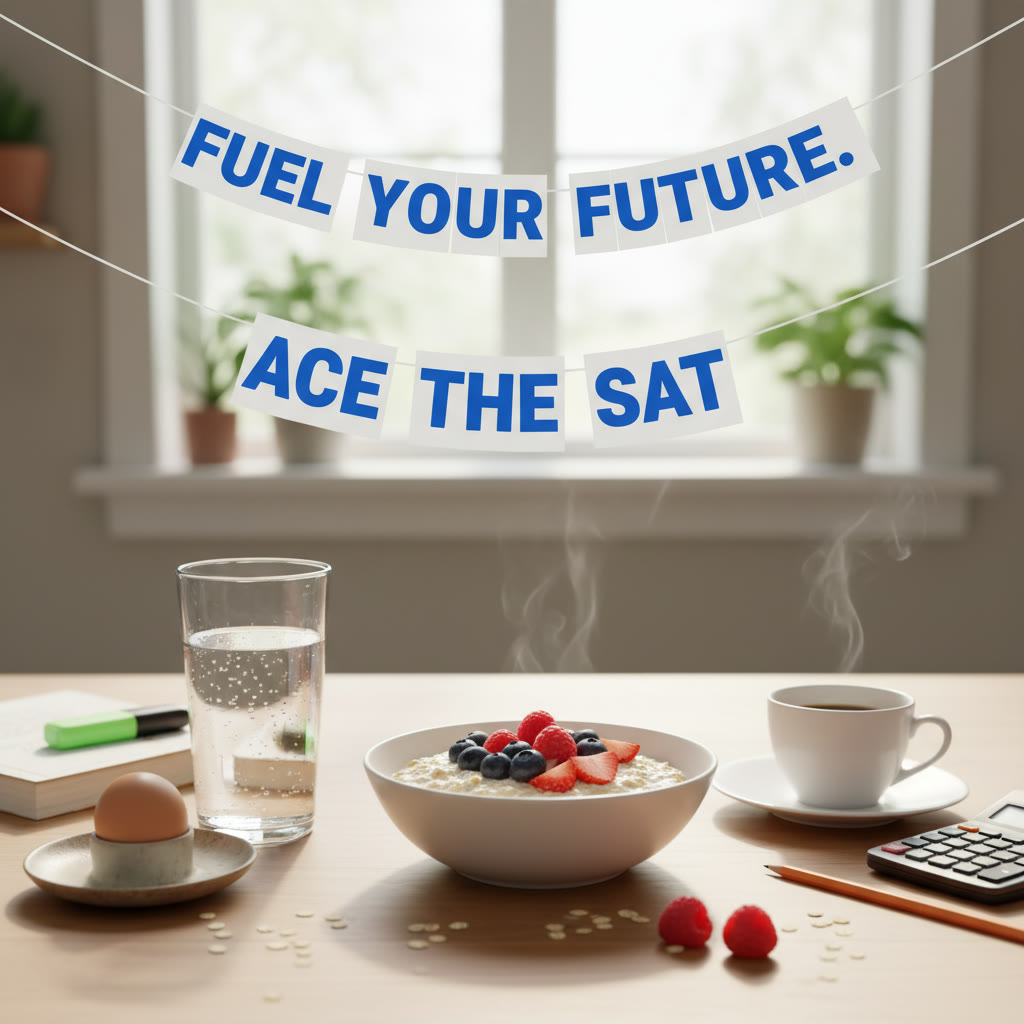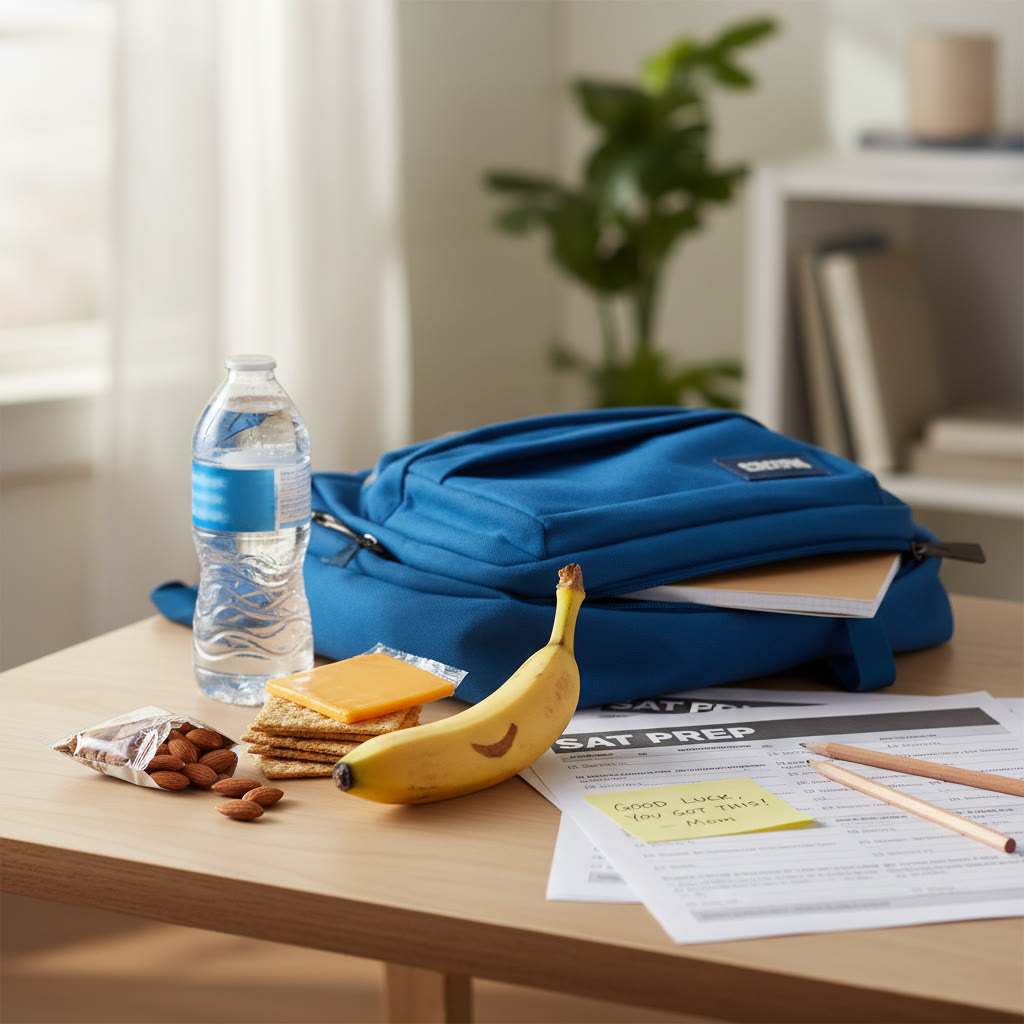The Link Between Diet and SAT Focus Levels
You’ve drilled vocabulary, conquered practice algebra, and timed dozens of full-length practice tests — but there’s one often-overlooked variable that quietly boosts or sabotages test-day performance: food. What you eat (and when) can change how steady your concentration is, how quickly you retrieve facts, and how gracefully you manage a late-afternoon fatigue slump during the SAT.
This post is a friendly, evidence-based guide for students who want to match smart nutrition with smart studying. We’ll break down the science, offer realistic meal and snack examples, spot common myths, and give you practical timing strategies so you can arrive at the test center calm, alert, and ready to think. Where it helps, I’ll mention how Sparkl’s personalized tutoring and benefits — like 1-on-1 guidance, tailored study plans, expert tutors, and AI-driven insights — can support building both study habits and practical routines including nutrition and timing.
Why food matters for thinking
Your brain is hungry. Although it makes up only about 2% of body weight, it accounts for roughly 20% of resting metabolic energy usage. That energy is mostly used to keep neurons firing and to support rapid communication across brain networks that underpin attention, memory, and reasoning — the exact cognitive functions the SAT tests.
Beyond calories, food supplies building blocks: glucose for immediate use, amino acids for neurotransmitter production, and fatty acids for neuronal membrane health. Micronutrients like iron, B vitamins, vitamin D, magnesium, and zinc support cellular energy pathways and mood regulation. So while test prep focuses on practice, diet influences how well practice shows up in the moment.
Key nutrients that support SAT focus
Glucose and steady blood sugar
The brain runs primarily on glucose. But big swings in blood sugar — a sugar spike from a pastry followed by a crash — can make you jittery, then foggy. Aim for carbohydrate sources that release energy gradually: whole grains, legumes, fruit paired with protein, and vegetables.
Protein and amino acids
Protein stabilizes blood sugar and provides amino acids like tyrosine and tryptophan, precursors for neurotransmitters such as dopamine and serotonin. Dopamine supports motivation and working memory — both helpful for tricky, multi-step problems.
Healthy fats
Omega-3 fatty acids (EPA and DHA) are linked to neuronal function and inflammation control. Fat also slows digestion, keeping energy steady over longer test sections. Sources: oily fish, walnuts, chia, flax, and moderate amounts of olive oil.
Micronutrients
Iron deficiency reduces attention and processing speed. B vitamins support energy metabolism and cognitive function. Vitamin D plays roles in mood. Magnesium helps with calm and muscle relaxation. Most people can get these from a varied diet; if you suspect deficiencies, check with a healthcare provider.
Practical pre-test strategies: the day before and the morning of
The day before
Think of the day before as rehearsal for the brain, body, and schedule. Prioritize sleep and steady fuel. Avoid drastic dieting or unfamiliar foods.
- Eat balanced meals with whole grains, lean protein, vegetables, and healthy fats.
- Hydrate consistently — water throughout the day matters more than chugging on test morning.
- Keep caffeine in a familiar range. If you normally drink a cup of coffee, do the same; don’t experiment with double espressos.
- Practice the timing of meals so you know what feels best during a long testing session.
Morning of the SAT
Breakfast should be reliable: steady-release carbs, protein, and a little healthy fat. The goal is a calm, focused mind for several hours.
- Examples: oats with Greek yogurt and berries; whole-grain toast with peanut butter and banana; scrambled eggs with spinach and a slice of whole-grain bread.
- Include a small amount of caffeine if you usually have it (e.g., a small coffee or tea) but avoid overdoing it to prevent jitteriness or a mid-test crash.
- Hydrate: a glass of water with breakfast, and bring a water bottle for the breaks (check testing-center policies first).
Snack smart between sections
Breaks on test day are short and precious. Snacks should be compact, not messy, and provide quick, steady energy.
- Banana with a small pack of almonds — quick carbs plus protein/fat.
- Greek yogurt cup with a bit of granola — if the testing center allows refrigerated items and you’re comfortable carrying it.
- Whole-grain crackers with cheese slices or nut butter packets.
- A small trail mix focused on nuts, seeds, and dried fruit (limit sugary candy).
Timing: when to eat and how much
Timing controls glucose availability and comfort. Hunger distracts; overfullness drains energy. Here’s a practical rhythm for many test-takers:
- Breakfast approximately 1–2 hours before the test starts to allow digestion but keep energy available.
- Small, sustaining snack during the official break(s) — nothing new or heavy.
- Hydration sips throughout the day; avoid excessive fluids right before a section to minimize restroom interruptions.
Example day timeline
Imagine an SAT that starts at 8:30 AM.
- 6:45–7:15 AM: Balanced breakfast (oats + yogurt + banana).
- 8:00–8:20 AM: Lightweight snack if you need it (handful of nuts) and final mental prep.
- 10:15 AM (break): Banana or crackers with cheese; water.
- After test: replenish with a mixed meal — lean protein, vegetables, and complex carbs.
Quick reference table: foods, benefits, and when to use them
| Food | Primary benefit | Best timing | Notes |
|---|---|---|---|
| Oatmeal + yogurt + fruit | Sustained energy, protein | Breakfast, 1–2 hours before test | Gentle on the stomach, low GI carbs |
| Whole-grain toast + nut butter + banana | Fast and sustained glucose + protein | Breakfast or quick pre-test | Portable and familiar |
| Eggs + spinach | Protein, choline, steady energy | Breakfast | Avoid heavy greasy cooking which can make you sleepy |
| Nuts & seeds | Healthy fats, protein; satiety | Short break snack | Small portion to avoid mouth dryness |
| Berries | Antioxidants, low GI carbs | Breakfast or snack | Great with yogurt |
| Water | Hydration, cognitive clarity | All day, small sips | Avoid gulping right before a section |
Common myths (and practical reality checks)
Myth: Carbs are bad on test day
Reality: Carbohydrates are the brain’s preferred quick fuel. The key is choosing complex carbs that release glucose slowly rather than refined sugary treats that provoke rapid crashes.
Myth: You should fast to sharpen focus
Reality: Mild hunger can sometimes heighten alertness, but real fasting often reduces working memory and endurance — both essential on the SAT. A balanced breakfast beats fasting for sustained cognitive performance.
Myth: Caffeine always helps
Reality: Caffeine can boost alertness but also anxiety and shakiness in some students. Stick to your usual habits; if you don’t normally consume caffeine, test day isn’t the time to start.
Putting it into practice: two sample meal plans
Reliable morning for an early SAT
Breakfast (7:00 AM): Bowl of steel-cut oats cooked with milk, stirred with a spoonful of peanut butter, topped with sliced banana and a few walnuts. A small cup of coffee or tea if that’s your normal routine. Water alongside.
Break snack (10:15 AM): Banana + 8–10 almonds. Small, portable, familiar.
Post-test: A balanced lunch with grilled chicken, quinoa, mixed salad, and an orange.
Light eater who gets teary with heavy meals
Breakfast (1–1.5 hours before): Smoothie made with Greek yogurt, frozen berries, a handful of spinach, and a tablespoon of ground flaxseed. Light but nutrient-dense, easy to digest.
Break snack: Whole-grain crackers with a cheese slice. Water in small sips.
Post-test: Hearty bowl of lentil soup and a side of whole-grain bread.
Beyond single meals: lifestyle habits that amplify nutritional gains
Sleep and recovery
Nutrition and sleep are partners. Poor sleep makes you reach for sugar and caffeine, which create a fragile cycle of energy spikes and crashes. Aim for consistent sleep in the week before the test to stabilize mood and cognitive control.
Regular exercise
Exercise regulates blood sugar, improves sleep, and enhances executive function. A brisk 20–30 minute walk on test morning (if time allows) can reduce anxiety more effectively than last-minute cram reading.
Practice under realistic conditions
During practice tests, mimic your planned test-day nutrition and timing. If a particular snack makes your stomach grumble, try a different one before the real exam. Sparkl’s personalized tutoring can help students fine-tune these practice-day protocols by integrating nutrition advice into tailored study plans and 1-on-1 guidance, using expert tutors and AI-driven insights to identify what routines work best for you.
Tracking and personalization: how to find your sweet spot
No two brains respond exactly the same to the same meal. Keep a simple log during practice tests: what you ate, when, how you felt (alertness, stomach, mood), and your score or sections where you felt sluggish. Over several trials you’ll detect patterns: doughnuts lead to midday fog for many; a protein-plus-carb breakfast often conserves focus for longer.
If you want structured help, Sparkl’s personalized tutoring benefits can be a useful complement. Their tutors can work with you one-on-one to craft tailored study plans that include recommended pre-test meals and timing based on your personal responses. AI-driven insights can also analyze your practice data to suggest small, evidence-based adjustments.
Real-world examples: small changes, big wins
Case 1: A student named Maya swapped a sugary cereal for overnight oats with Greek yogurt and saw her endurance improve across three practice tests; she felt there was less mid-section brain fog and her math accuracy improved in the afternoon block.
Case 2: Jordan was a heavy coffee drinker before switching to one smaller cup and adding a protein-rich snack before the test. The result was fewer shakes and calmer pacing through the critical reading passages.
These illustrate a simple truth: small, sensible changes — practiced and personalized — can create measurable cognitive benefits under exam conditions.
Final checklist: food and focus on SAT day
- Eat a balanced breakfast 1–2 hours before the test with complex carbs, protein, and a little healthy fat.
- Hydrate throughout the day, sipping rather than gulping.
- Bring a small, portable snack for the official break — familiar and tested during practice.
- Match caffeine to your normal habit; avoid new stimulants.
- Aim for consistent sleep and a light morning exercise if it helps calm nerves.
- Practice your full routine under simulated conditions and adjust based on what your body tells you.


Wrapping up: food is one of your study tools
The SAT is a marathon of attention, memory, and logic. You already know the value of practice tests and grit; now add intentional fuel to that toolkit. Thoughtful choices about what, when, and how much to eat will keep your brain operating smoothly for longer and reduce the chance that hunger or a sugar crash becomes the weak link on a big day.
Start simple: practice consistent breakfasts, carry a tested snack for the break, and use sleep, hydration, and light exercise to support the food choices you make. If you want extra support, Sparkl’s personalized tutoring and benefits — from 1-on-1 guidance to tailored study plans and AI-driven insights — can help you integrate nutrition into a plan that matches your learning style and test timing. With a bit of preparation, you’ll give your best knowledge the best chance to shine.
Good luck — fuel well, rest well, and go show the SAT what you’ve got.




















No Comments
Leave a comment Cancel